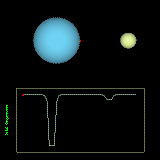Eclipsing Binary Stars

- 728Kb QuickTime Movie
- 53Kb MPEG Movie
- 288Kb Animated GIF
This movie simulates an eclipsing binary star system consisting of an A0v
primary and G5v secondary in a circular orbit about each other. The
orbital plane is tilted with respect to the line of sight by 6°. The
top half of the frame shows the appearance of the two stars, with the red
dot marking the center of mass of the system (just outside the radius of
the blueish A0v primary star). The light curve of the total system is
traced out in the lower panel as they orbit. Two orbits full orbits are
shown, with a red marker used on the light curve to show the current
location.
Notice that the deepest eclipse occurs when the secondary is in front of
the primary. This is because of the nearly factor of two greater effective
temperature of the primary (10,000K compared to 5,500K). Since surface
brightness scales like T4, more light is blocked when the
secondary is blocking part of the primary, than when the primary completely
blocks the secondary.
[Credit: R. Pogge, OSU]
[Details]
Return to:
[
Lecture 9 Page
|
Unit 1 Page
|
Astronomy 162 Homepage]
Updated: 2007 November 3 [rwp]
Copyright
Richard W. Pogge, All Rights Reserved.

